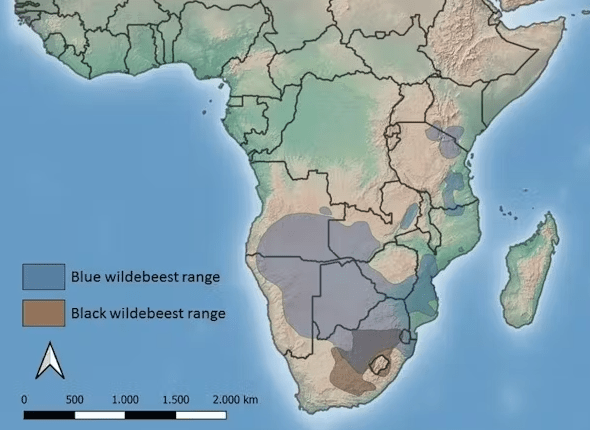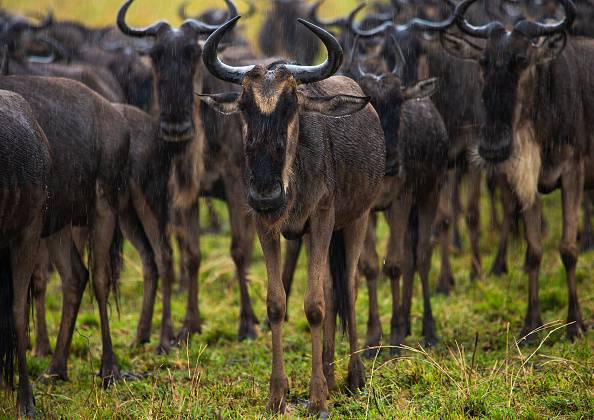
Wildebeest, Rift Valley Province, Masai Mara, Kenya. (Photo by Eric Lafforgue/Art in All of Us/Corbis via Getty Images)
The wildebeest is a large African antelope with characteristically curved horns, famous for its large migrations across the grasslands of eastern and southern Africa. 150 years ago, they migrated in droves across the continent in search of grazing, water, and suitable areas to give birth.
Migration is essential to maintaining their large populations. But their routes are blocked by roads, oil and gas pipelines, railroads, fences, cities, livestock, and farmland.
Today, the only remaining large-scale migration is the famous Serengeti Mara migration in East Africa. Approximately 1.4 million wildebeest, accompanied by approximately 200,000 zebras, 400,000 gazelles and 12,000 elands, migrate up to 3,000 km each year, following seasonal rainfall patterns.
Even this migration is now threatened by new road and rail projects, uncontrolled and unplanned development, and rapid population growth near the edges of the Serengeti Mara ecosystem.
Now, in a new study, we have found that disruption of migratory routes has a genetic impact on an animal's long-term survival.
Our results indicate that populations of wildebeest that cease to migrate are genetically less healthy than those that continue to migrate.
Their populations do not mix with other wildebeest groups, so they are more inbred and genetically isolated. We expect this to lead to lower survival rates, reduced fertility, and other negative health effects.
It's not just wildebeest that are threatened with blocking their migration, but many other species as well. Wildebeest grazing keeps plants healthy and distributes nutrients. Wildebeest are prey for predators, carrion is food for scavengers, and their droppings support millions of dung beetles.
With the loss of migrants, Kenya and Tanzania risk losing huge tourism revenues that benefit governments and communities.
population collapse
Our study is the first time the genetic effects of migration have been investigated in wildebeest.
We analyzed the genetic material of 121 blue wildebeest and 22 black wildebeest. We selected these 143 wildebeest from all ranges on the African continent, from South Africa to Kenya. This meant that general genetic comparisons could be made between migratory and non-migratory bird populations.

Migratory wildebeest populations showed greater genetic diversity. They engaged in extensive random mating, which reduced inbreeding levels compared to neighboring populations whose migration patterns had recently been disrupted. Found this in multiple places.
The conclusion is clear. Regardless of where they live on the continent, there is an overall negative genetic impact on wildebeest populations whose migration is impeded.
Reduced genetic diversity makes animals less healthy and more susceptible to disease and infertility. Populations with low genetic diversity have a lower ability to evolve and cope with changes in their environment. Their survival could therefore be threatened if climate change continues to intensify and there is not enough genetic variation to adapt.
already vulnerable
Large, non-migrating wildebeest populations are already vulnerable, and their numbers will decline if they are unable to migrate. This is because they don't have enough to eat, don't have access to nutritious birthing areas, and don't have enough drinking water during the dry season.
They also cannot escape from predators, are at risk of poaching, and are vulnerable to disease outbreaks such as rinderpest.
Although the total number of wildebeest across the continent has remained fairly stable, many local migratory populations have experienced steep declines, and some have even gone extinct in recent decades.
We are seeing this impacting some populations in Kenya, Tanzania and Botswana.
For example, migration in Mara Loita has declined by 76%, from about 150,000 wildebeest in the 1970s to about 36,500 wildebeest, all of whom were settled, by 2021.
In Botswana, fences were installed to protect cattle from contact with migratory wild animals, and the Kalahari wildebeest population decreased by 94.2% from about 260,000 in the 1970s to less than 15,000 in the late 1980s. It has decreased by more than 20%.
These findings highlight the critical need to preserve animal migration routes.
put things in perspective
Policy makers should pay special attention to preserving the wildebeest's ancient natural migration routes. Here are the steps you can take:
- Protecting the volatile arid and semi-arid lands where wildebeest live
- Protect important drought refuges such as swamps and forests
- Regulate and strategically plan the expansion of settlements, including the cultivation of urban centers, infrastructure, fences and pastoral lands.
- Designate zones for grazing and settlement of wild animals and livestock
- Develop and enforce clear rules and regulations governing land use, land sales, leasing, and development along important wildlife migration routes.
- Reintroduce locally endangered wildlife species, such as wildebeest, from external ecosystems wherever possible.
Addressing these priorities will make efforts to conserve and restore populations of endangered ungulates more focused, coordinated, and effective, and to improve the lives of these animals. It can contribute to long-term protection.
Joseph Ogutu is a senior researcher and statistician at the University of Hohenheim. This article was first published by The Conversation.

